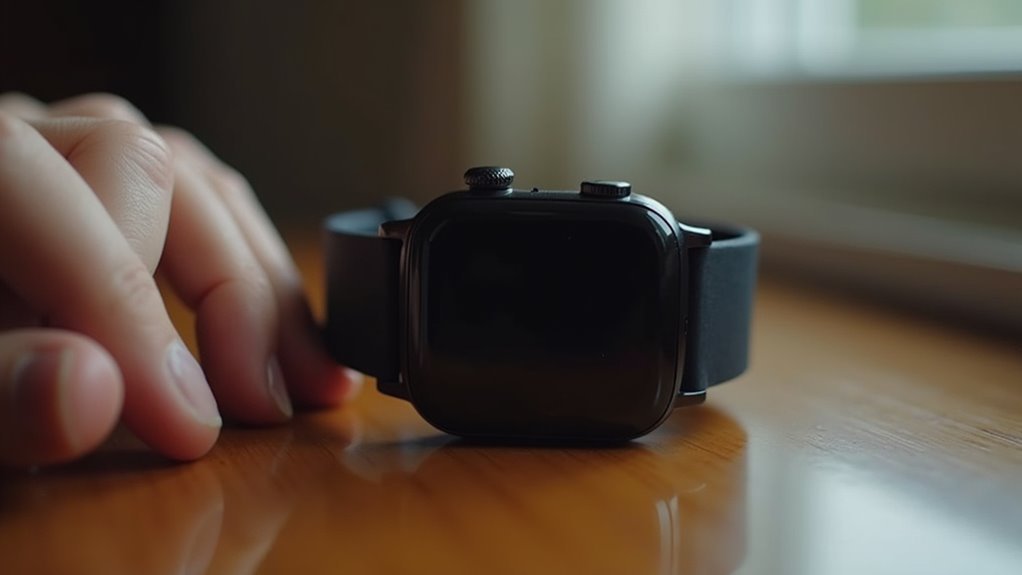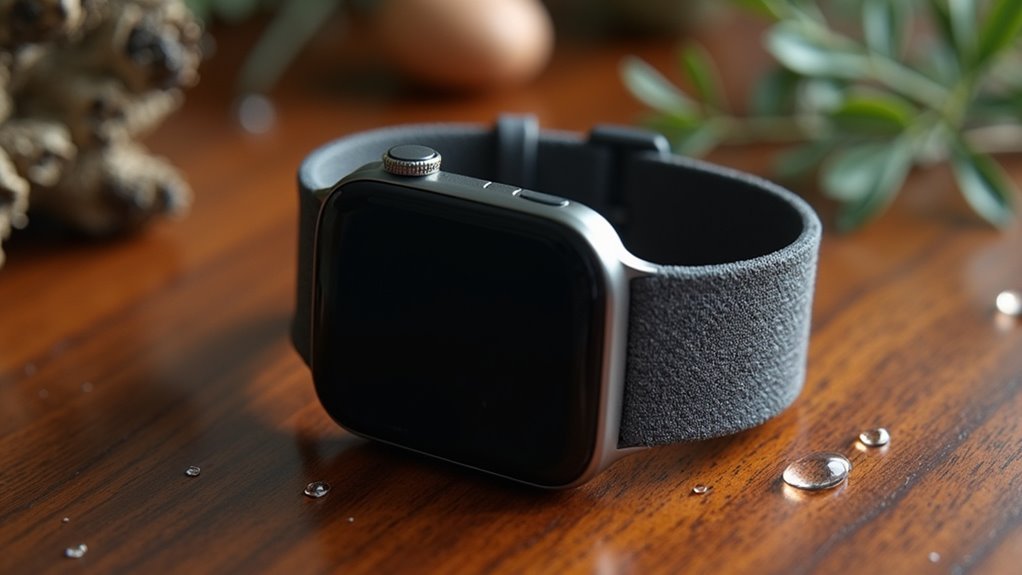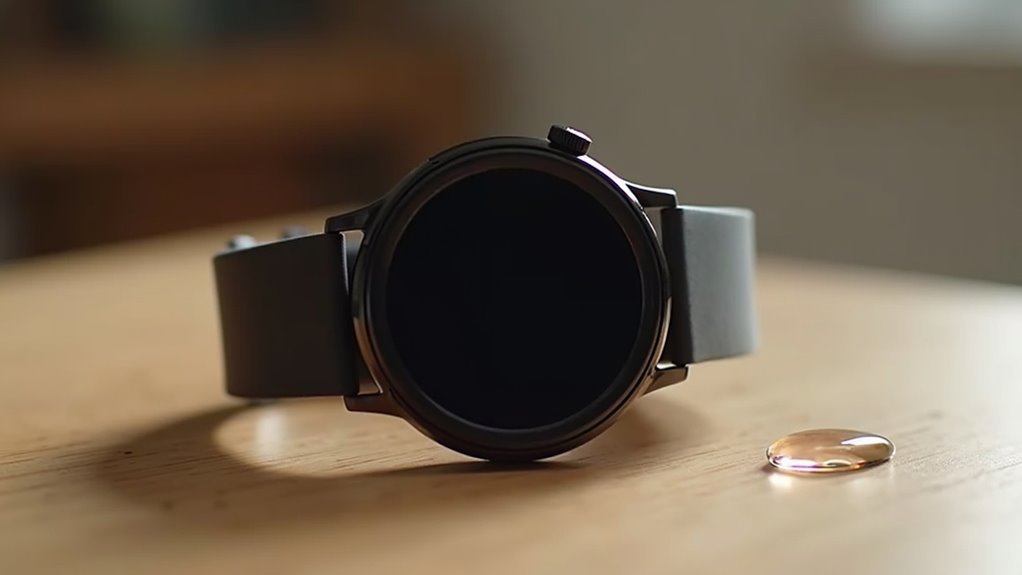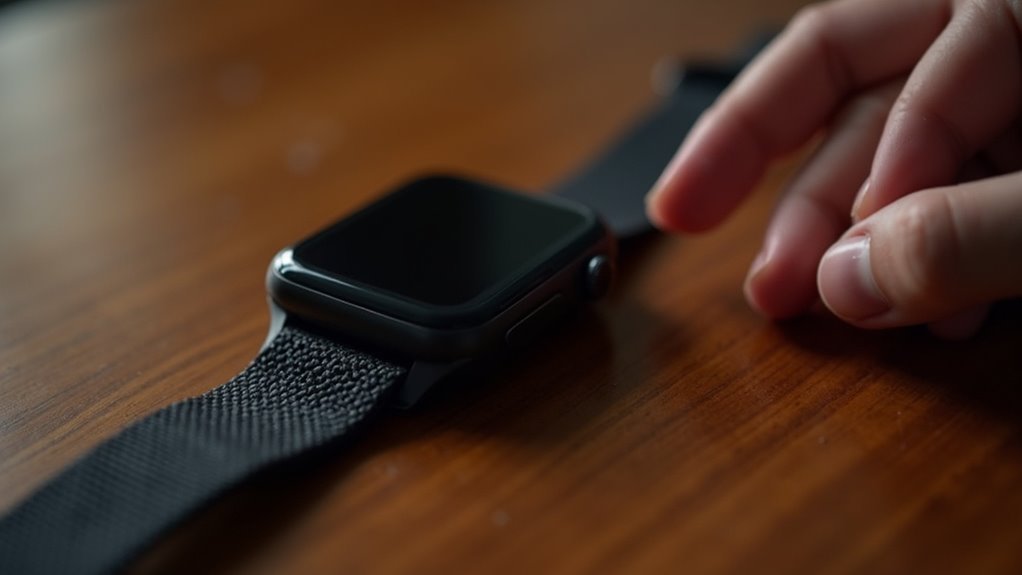Your sweat contains unique metabolic signatures like lactate, urea, and glutamate that create a distinct biochemical fingerprint for identity verification. Wearable devices use electrochemical sensors and microfluidic channels to analyze these biomarkers in real-time, offering enhanced security compared to traditional passwords or PINs. The technology relies on flexible electronics with advanced nanomaterials that conform to your skin while processing biometric data. Discover how this revolutionary authentication method could transform your digital security experience.
The Science Behind Sweat-Based Biometric Recognition

While traditional biometric systems rely on physical characteristics like fingerprints or facial features, sweat-based authentication harnesses your body’s unique metabolic signature to verify your identity.
Your sweat contains distinct metabolites like lactate, urea, and glutamate that create a biochemical fingerprint as individual as your DNA. These compounds vary based on your age, sex, activity level, and physiological state, making your sweat profile nearly impossible to replicate.
Advanced wearable sensors use electrochemical and optical detection methods to analyze these metabolites in real-time. The technology measures specific enzymes through lactate oxidase, urease, and glutamate dehydrogenase assays.
Multivariate analysis then processes this data to distinguish you from others statistically. This approach eliminates spoofing risks since your metabolic processes can’t be easily mimicked or hacked. Unlike traditional fingerprint readers where 90% of fake samples initially passed verification, sweat-based systems provide enhanced security through physiological indicators that cannot be reproduced in synthetic materials.
Core Technologies Enabling Sweat Authentication Systems
You’ll find that sweat authentication systems rely on three fundamental technologies working in harmony to capture and analyze your unique biochemical signature.
Electrochemical sensors detect specific biomarkers in your sweat, while microfluidic channel networks efficiently collect and route these samples for analysis.
Flexible electronics then process this data seamlessly, adapting to your body’s movements without compromising accuracy or comfort. These systems provide non-invasive, continuous monitoring capabilities that make them ideal for real-time authentication applications.
Electrochemical Sensor Integration
As sweat-based authentication systems move from concept to reality, electrochemical sensor integration serves as the technological backbone that transforms biological signals into actionable digital data.
You’ll find that advanced nanomaterials like graphene and Ti₃C₂Tₓ MXene dramatically improve sensor sensitivity and conductivity, while enzyme-modified MOFs enable detection limits as low as 0.34 μM for specific biomarkers.
Your wearable device relies on integrated microcontrollers that process electrochemical data in real time, transmitting results wirelessly via BLE protocol to your smartphone.
The system’s multilayer architecture combines flexible PDMS substrates with microfluidic chips, ensuring comfortable wear while maintaining robust signal capture.
Self-healing and anti-fouling properties enhance longevity, while advanced filtering algorithms reduce noise and improve authentication reliability in dynamic sweat environments. Authentication systems must address the fundamental challenge of acquiring representative sweat samples to ensure accurate biometric verification across different physiological conditions.
Microfluidic Channel Networks
Precision engineering transforms how your wearable device captures and controls sweat flow through microscopic channel networks that serve as the circulatory system of authentication technology.
These channels, fabricated from polymers, paper, and textiles using techniques like 3D printing and photolithography, create flexible PDMS pathways that integrate seamlessly with sensing electrodes.
Your device uses capillary forces to transport sweat through vertical and horizontal microchannels, while capillary burst valves regulate flow for precise sampling.
Hydrophobic stop valves prevent leakage and cross-contamination between channels. The system maintains air-liquid pressure equilibrium through specialized vent structures, ensuring stable flow rates as low as 0.7 μL/min.
Multi-layered designs process over 300 μL per measurement, directing sweat to multiple sensors simultaneously while preventing dilution and evaporation. Advanced multidraw collection capabilities enable capture of multiple independent samples from the same session for enhanced authentication accuracy.
Flexible Electronics Implementation
When sweat reaches your device’s sensing chamber, flexible electronics must bend, stretch, and conform to your skin while maintaining precise electrical connections that enable accurate biometric authentication.
Silver nanowires, graphene, and carbon nanotubes create stretchable conductive pathways that won’t break under deformation. Liquid metals flowing through microchannels provide highly flexible electrode designs that adapt to your body’s movement.
Polymer composites with conductive fillers form mechanically robust electrodes that accurately detect sweat metabolites. Roll-to-roll gravure printing enables mass production of these sensors at low cost.
Biocompatible conductive hydrogels improve how the device conforms to your skin, creating stable electrode-skin interfaces that enhance signal quality. These hydrogels prevent motion artifacts that traditionally interfere with accurate sensor readings.
Multiple sensing elements integrate on flexible substrates, allowing simultaneous detection of various biomarkers for thorough authentication verification.
Microfluidic Channels and Biomarker Detection Methods
You’ll need precisely engineered microfluidic channels to guide sweat from your skin’s surface directly to integrated sensor arrays for reliable authentication.
Your device’s electrochemical sensors, typically laser-engraved graphene electrodes on flexible substrates, must detect multiple biomarkers like glucose, uric acid, and electrolyte levels simultaneously.
The system’s real-time analysis capabilities depend on wireless circuits that continuously monitor these biomarker concentrations while accounting for factors like sweat rate and temperature variations. Advanced nanomaterials enhance the sensitivity required to detect these target analytes at the low concentrations typically found in sweat biofluid samples.
Channel Design Fundamentals
The foundation of effective sweat-based authentication lies in carefully engineered microfluidic channels that transport, process, and analyze biological samples at microscopic scales.
These channels form the backbone of wearable authentication systems, determining how efficiently your sweat flows and how accurately biomarkers are detected.
Understanding channel fundamentals guarantees ideal device performance:
- Rectangular cross-sections facilitate easier manufacturing through layering techniques while maintaining consistent fluid flow patterns.
- Precise dimensions typically measure tens of micrometers deep, hundreds wide, and thousands long for ideal sample processing.
- PDMS materials provide the flexibility and biocompatibility essential for comfortable wearable applications.
- Strategic geometry directly influences fluid dynamics, enhancing biomarker detection efficiency and overall system sensitivity.
These design principles create reliable, miniaturized systems perfect for continuous authentication monitoring. Proper channel design must maintain structures with aspect ratios no lower than 1:10 to ensure structural integrity and reliable fluid flow throughout the authentication process.
Electrochemical Sensor Integration
Once microfluidic channels establish the foundation for sweat transport, electrochemical sensors transform your wearable device into a sophisticated detection system capable of identifying and quantifying specific biomarkers in real-time.
These sensors employ amperometric and potentiometric methods to detect critical biomarkers like lactate, uric acid, and ions such as sodium and potassium.
You’ll benefit from multiplexed analysis capabilities that simultaneously monitor multiple biomarkers, providing thorough health insights during exercise or daily activities.
The sensors maintain mechanical robustness under deformation while delivering high sensitivity—PCN-based sensors achieve detection limits as low as 4.13 μM for uric acid.
Integration with portable potentiostats ensures interference-free data collection, enabling personalized health monitoring and point-of-care diagnostics through continuous, non-invasive assessment. Advanced fabrication utilizes screen-printed carbon masters in clean-room free environments, making large-scale production of these wearable sensors both cost-effective and accessible.
Real-Time Analysis Capabilities
When microfluidic channels interface with advanced detection systems, they create real-time analysis capabilities that transform sweat into actionable health data within seconds.
You’ll experience rapid sampling that processes over 300 μL of sweat in just 40 seconds, enabling immediate physiological insights.
These systems deliver thorough biomarker detection through:
- Glucose monitoring – Detecting concentrations from 0.05 mM to 0.40 mM for exercise tracking
- pH measurement – Analyzing levels between 4.0 to 6.5 for metabolic assessment
- Ion sensing – Simultaneously monitoring Na+, K+, and other electrolytes
- Multiplexed analysis – Processing multiple biomarkers concurrently for complete health profiles
Your wearable device maintains air-liquid pressure equilibrium, preventing leakage while ensuring consistent flow control.
The PDMS channel materials enhance sweat collection through improved hydrophilicity, delivering accurate measurements that remain stable during body movement. These sensors utilize capillary action as the primary driving force to efficiently transport sweat without external power requirements.
Advanced Materials for Enhanced Sweat Collection
Revolutionary nanomaterials are transforming how wearable devices collect and analyze sweat for authentication purposes.
Laser-induced graphene electrodes create highly porous structures that maximize sweat adsorption while providing stable, large surface areas for capturing biomarkers.
You’ll benefit from 3D networks of gold and silver alloys that enhance electrochemical stability and signal conductivity.
Carbon-based nanocomposite materials improve your sensor’s sensitivity and flexibility, ensuring accurate readings during movement.
Microfluidic channels guide sweat from your skin directly to sensor arrays, minimizing evaporation through hydrophilic materials and protective textile layers. Epidermal microfluidics technologies enable precise flow control through integrated microvalves that regulate sweat transport rates for optimal biochemical analysis.
These biocompatible adhesives maintain secure sensor contact for multi-day use while remaining comfortable.
The noble metal construction resists oxidation, maintaining sensing accuracy for up to three weeks under continuous use.
Real-Time Analysis Through Flexible Electronics Integration

These advanced materials reach their full potential when paired with sophisticated flexible electronics that process sweat data instantaneously.
You’ll find that flexible circuit boards integrated into these sensors enable seamless signal processing and wireless data transmission, while stretchable materials guarantee comfort during continuous monitoring.
This integration transforms raw sweat into actionable health insights through:
- Microfluidic channels that collect samples without contamination
- Laser-modified graphene nanocomposites that enhance sensor durability and specificity
- Conformal interfaces that create tight seals isolating sweat from environmental contaminants
- Wireless transmission capabilities that send data to your smartphone for real-time analysis
You’re getting continuous biomarker monitoring for glucose, lactate, sodium, and potassium levels, plus skin temperature measurements that contribute to your thorough health profile. The device provides molecular level tracking that offers far more comprehensive physiological insights than traditional wearable sensors that only capture basic metrics.
Design Requirements for Skin-Conformal Authentication Devices
Creating effective skin-conformal authentication devices demands a delicate balance between technological sophistication and biological compatibility.
You’ll need ultra-thin, lightweight designs that move naturally with your skin’s deformation while maintaining signal fidelity. The device must incorporate silicone elastomers for biocompatibility and multilayered thin films for conformality. Your authentication system requires wireless integration to eliminate cumbersome cables and modular components for versatile applications.
Consider your skin’s fragility when selecting gentle silicone adhesives that won’t cause trauma during repeated use. The device’s mechanical properties should match your epidermis thickness and bending stiffness.
You’ll want waterproof encapsulation protecting both skin and electronics while enabling easy disinfection. Customizable sizing guarantees proper fit across different body regions, while seamless lamination minimizes movement artifacts during authentication processes. Achieving low impedance at the electrode-skin interface ensures reliable signal acquisition during the authentication process.
Accuracy Challenges and Clinical Validation Needs

While skin-conformal devices represent a breakthrough in wearable technology, you’ll face significant hurdles when validating their accuracy for authentication purposes. The challenge lies in establishing reliable measurement protocols that work consistently across different users and environments.
Your validation strategy must address four critical areas:
- Blood-sweat correlation studies – You need extensive testing to correlate sweat measurements with blood biomarkers for clinical reliability.
- In vivo validation testing – Real-world conditions require thorough field testing to verify sensor accuracy.
- Regional measurement correlation – You must understand how localized sweat measurements relate to whole-body physiological responses.
- Large-scale systematic studies – Establishing authentication reliability demands extensive user studies across diverse populations and conditions.
The filtering of blood affects both molecular weight and concentration in sweat, creating additional variables that complicate authentication accuracy. Without rigorous validation, your sweat-based authentication system won’t achieve the accuracy standards required for secure applications.
Privacy Protection and Biometric Data Security
When you implement sweat-based authentication, you’re handling some of the most sensitive biometric data imaginable. Your sweat contains unique biochemical markers and amino acid profiles that reveal personal health information.
Unlike passwords, this data can’t be changed if compromised, making security essential. You’ll need robust encryption for biometric templates and secure on-device storage to prevent breaches.
Consider implementing multi-factor authentication and Trusted Execution Environments within wearables for enhanced protection. Anomaly detection systems can identify suspicious authentication attempts.
Transparency remains important—you must clearly communicate data collection practices and provide opt-out options. Since sweat data inherently links to your identity, anonymization proves challenging. The collection process involves small sensors that monitor sweat levels directly from your fingertips where eccrine glands are most concentrated.
You’ll face ongoing trade-offs between data minimization and authentication accuracy while steering through underdeveloped regulatory frameworks.
Future Developments in Wearable Authentication Technology
The authentication landscape for wearables stands on the brink of revolutionary transformation.
You’ll witness unprecedented advances that’ll reshape how you interact with your devices securely.
Here’s what’s coming next:
- Multi-Factor Integration – You’ll experience seamless authentication combining sweat analysis with heart rate patterns, gait recognition, and voice biometrics for ironclad security.
- AI-Enhanced Accuracy – Advanced algorithms will analyze your unique physiological signatures in real-time, eliminating false positives and strengthening authentication reliability. Generative AI will transform these authentication systems from simple verification tools into intelligent personal security coaches that learn and adapt to your behavioral patterns.
- 5G-Powered Security – Lightning-fast connectivity will enable instant biometric verification across your entire device ecosystem without compromising data integrity.
- User-Centric Interfaces – You’ll enjoy intuitive setup processes and effortless authentication experiences that adapt to your preferences and daily routines automatically.
Frequently Asked Questions
How Long Can I Wear a Sweat-Based Authentication Device Continuously?
You can wear a sweat-based authentication device continuously for up to three weeks. The device’s designed with comfortable, tape-free materials that guarantee durability and user comfort during extended wear periods without compromising performance.
What Happens if I Don’t Sweat Enough for the Device to Work?
If you don’t sweat enough, the device’s accuracy decreases considerably. You’ll experience authentication failures and reduced functionality. The device can’t collect sufficient data from your sweat to verify your identity effectively.
Can Medications or Diet Changes Affect My Sweat Authentication Accuracy?
Yes, medications like antipsychotics and stimulants can alter your sweat patterns, while diet changes affecting hydration and electrolytes may impact authentication accuracy. You’ll need system calibration to account for these variations.
How Much Do Sweat-Based Authentication Wearables Typically Cost Consumers?
You’ll find specific pricing isn’t widely available since sweat-based authentication remains emerging technology. Entry-level wearables with sweat sensors vary markedly in cost depending on brands, features, and advanced technological capabilities integrated.
Are Sweat Authentication Devices Waterproof for Swimming or Showering?
You’ll find limited waterproof sweat authentication devices currently available. Most pause data collection underwater, though SIS-based microfluidics technology shows promise for future swimming-capable devices with better water resistance than current options.
In Summary
You’re witnessing the dawn of a revolutionary authentication era where your body’s natural processes become your password. Sweat-based biometrics won’t just change how you access devices—they’ll redefine personal security entirely. You’ll soon wear authentication systems that’re as natural as breathing, offering unprecedented accuracy while protecting your privacy. The future isn’t coming; it’s already forming on your skin, one drop at a time.





Leave a Reply